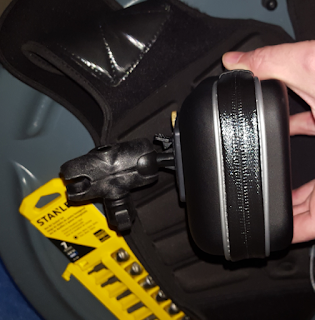Adding a GPS mount to a sportbike - Yamaha R3
I own a 2015 Yamaha R3, a 320 cc sportbike, 2 strokes, 6 gears. Nothing fancy. I can be in 4th gear doing 30. A bike with significant power would still be in 2nd gear, maybe even 1st, doing 30. But I am not a speed demon and while pickup could be better, it works for my riding needs. Besides, I am not planning on entering any races.
Problem: sportbikes have flat handlebars that radiate from the central steering post (not the correct technical term - I am still learning basics like part names, etc. But you get the idea.) Further, they have very little room between the center island and the handles. Ordinary streetbikes have round handlebars and most GPS mount solutions are designed for ordinary streetbikes. Racing and racing-styled bikes are not thought of as having much need for a place for a GPS. That to me seems idiotic given that most sportbikes sold are not to racers but to ordinary guys like me. It stands to reason we'd need a place to mount a GPS. Most streetbikes now come with GPS mounting ready or designed to expect it.
Further, there is virtually NOTHING out there about adding a GPS to a sportbike. I came across just one place where adding a GPS to a sportbike and esp. to my model was discussed but the author had no rearview mirrors on his bike so his solution used one of the mounting holes for such a mirror. My bike has those mirrors. There are only 2 utility screw wells on the Yam. R3 on the handlebars and both are 5 or 6 mm width. RAM ball mounts come with different post sizes including 6 mm but the post is far too short to sink into the screw well on the handlebars. I learned this by ordering 2 different RAM ball mounts from Amazon and neither worked that way. I finally decided that the only way this was going to happen for me was either to drill a hole or two in my handlebars (requiring professional intervention) or by using a screwless solution. BTW, at one point I went to see if I could get a male-to-female screw adapter made for one of the RAM mounts going from 5 mm male to 10 mm female. I found a fabrication shop that would do it but for over $150. To get just one such adapter made would have cost $150+. Not doing that!
To create the solution I needed without spending $400, $500 on it, I knew I had to get creative. After a total of three weeks waiting for parts to arrive and trying different things I finally found it. Because there is a near complete dearth of how-tos about attaching a GPS to a sportbike, I decided to document my solution here. Unfortunately if you are looking for a marketed end-to-end out of the box solution you will not find one, at least not of this writing. At one point I even called my local cycle shop to ask if they had ever installed a GPS onto this kind of bike and they said literally no one had EVER asked them about this before. I find this hard to believe but whatever.
Following is the parts list and cost:
1. One (1) ChargerCity XXL Water Resistant 5" GPS Case for Garmin Nuvi Drive: 18.95 (https://www.amazon.com/gp/product/B01B5A38MA/)
2. One (1) Ram Mount Composite Short Double Socket Arm for 1-Inch Ball Bases: 8.99 (https://www.amazon.com/gp/product/B005KWPJ04/)
3. One (1) Ram Mount 2.5-Inch Composite Round Base with the AMPs Hole Pattern and 1-Inch Ball: 7.49 (https://www.amazon.com/gp/product/B003N034SE/)
4. One (1) Garmin Drive 50 USA LM GPS Navigator System, refrurbished: 109.95 (https://www.amazon.com/gp/product/B01A1HL9Z6/)
5. One (1) Anker PowerCore 10000 Portable Charger: 31.99 (https://www.amazon.com/dp/B0194WDVHI)
6. One (1) MightyTie MT141200 15-Inch Cable Ties, 100-Count, 120 Pound: 9.42 (https://www.amazon.com/gp/product/B00CBAPNIG/)
The GPS I got on the cheap. It need not be that same model, but if you are going to use the GPS case listed above (item 1) the GPS you get needs to fit into it. Note that the approach I took requires an external battery for the GPS and hence item no. 5 listed above. The small USB cord that comes with the GPS is used to transfer data from your PC to the GPS (maps etc.) as well as power the GPS unit should you use it that way, and in this case, you will. (You may want to consider buying spare such cables. You can get them from Garmin at a premium or online at other places. Amazon had them but not the shorter cables needed here so I looked on eBay and found a couple vendors. I nabbed three spares for cheap at https://www.ebay.com/itm/Garmin-USB-Cable-Part-010-10723-01-0101072301-GPS-cord/310213551922 )
In truth once you have the ball mount in place you can use whatever GPS you want to and whatever case you want to provided it is 1" RAM ball mount-ready.
The idea here is that when you need to use a GPS you can attach the case to the mount (item 3) and place the Garmin GPS unit into the case along with the battery. The battery (item 5) is the best such of its kind I have ever seen. I have tried several others and most are not as reliable. The battery is pricey but IMO worth it and a GPS unit is a power-hungry thing. A high-amp-output battery that holds a lot of energy is needed. I am guessing this battery would probably serve as long as 8 hours of continuous use on the GPS unit but I have not tested that. The battery is also small enough that it can be moved upward in the case to allow the GPS power cord to enter the GPS unit without it pushing against the battery so that it lays flat. The case is deep enough that the battery can lie in it then have the GPS on top of it and it's all good.
The ties (item 6) are used to secure the RAM mount (item 3) in place on the handlebars. See the pictures below. You will note how I tied the base down is quite deliberate. I suggest tying the rightmost (as you face it) tie down first, then the second tie going from the upper left to lower right of the mount, using the tie catch of the first tie as a holding point. Note the two ties create an opposing tension on one another that serves to hold the mount down very securely. The ties (item 6) are industrial strength and meant for use in many applications requiring strength. Cutting the ties after securing them requires a very sharp utility knife and some persistence. These are not little twist ties that come with food packages!
The pictures explain the solution. Now when you go somewhere needing a GPS you can just put the unit and battery into the case. Then when you arrive, take it out and unplug the unit and shut it off. That way it is not present to get stolen if you leave your bike unattended. As for the entire mount, when not intending to use GPS, you can always remove the whole thing leaving just the installed RAM mount on the bike.
Re the charger (item 5), I myself own two. I use one with my smartphone, carrying it around attached all the time to the phone with a 12" micro USB cord, so I don't worry about the phone dying. You may want to order 2 or 3 because I guarantee once you see this battery do what it does for the GPS you will want one for your phone. Because I use it I never run out of juice on my phone. I just plug the battery in nightly to charge it and it serves without issue the whole next day. I can actually use it two days straight without recharging it.
I hope this helps someone out there.










